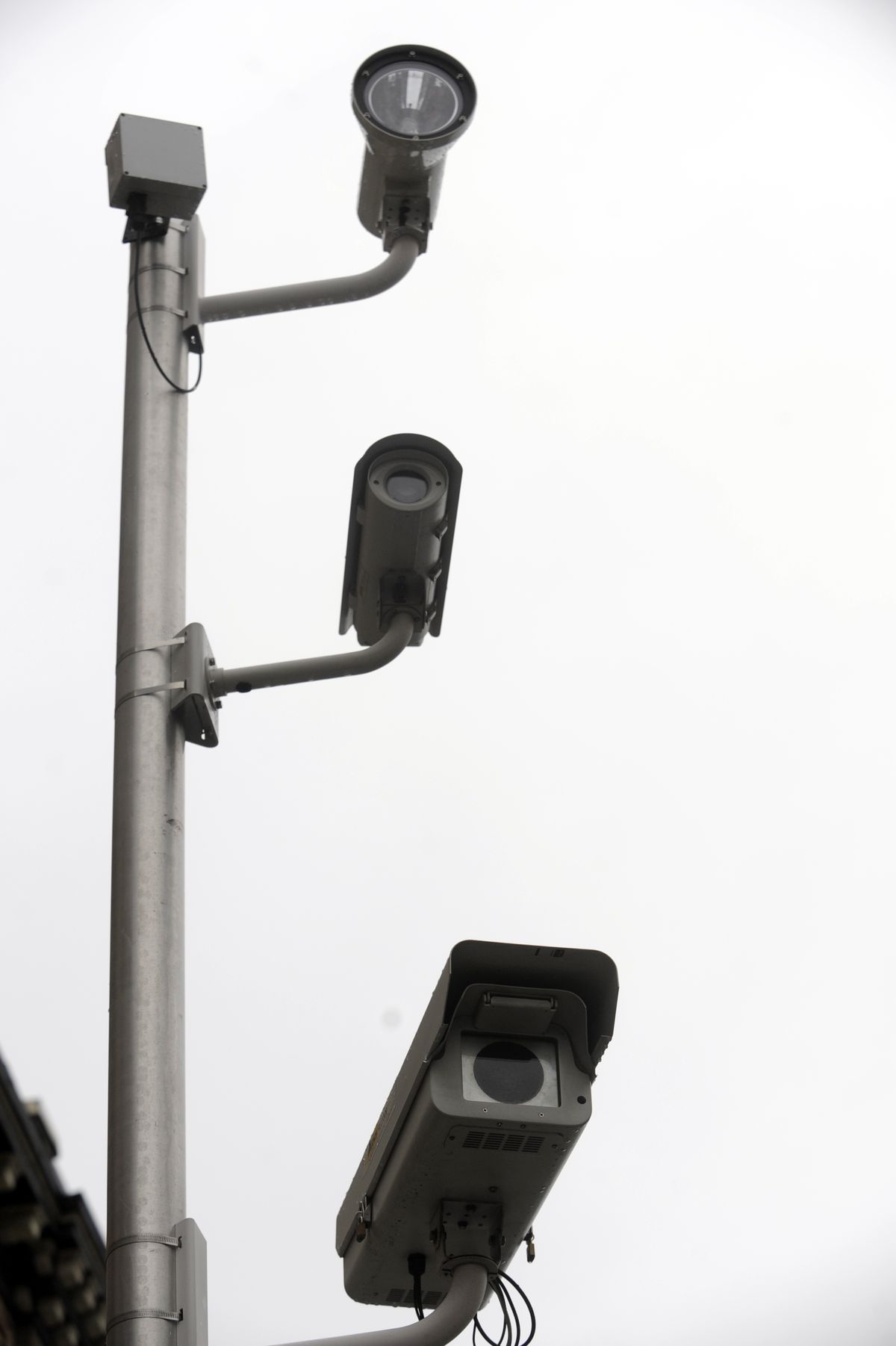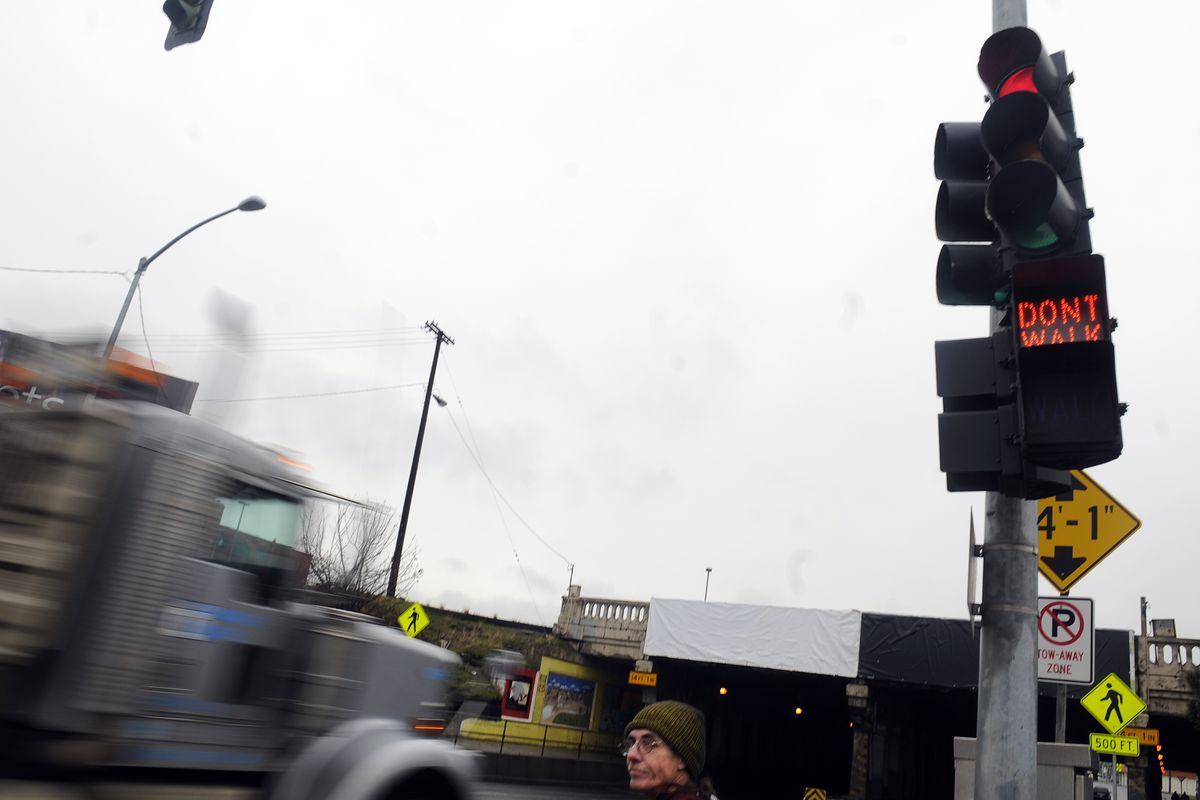Red light cameras yet to signal safety
First year saw more collisions at monitored intersections
The red light camera system has a control box to monitor the roadway and uses two cameras to videotape and photograph red light runners.
Intersections where Spokane installed red light cameras in 2008 in the name of safety saw an increase in crashes and injuries in the first year of the controversial program.
There were 38 collisions at the three intersections the year after the city began fining violators caught on tape. That’s up from 32 the previous year, according to police collision reports provided to The Spokesman-Review.
Injury accidents at the intersections also rose from 11 the year before to 14 after.
Spokane Mayor Mary Verner called the data “interesting,” but cautioned that it’s too early to make a final judgment on camera enforcement.
“The program has been effective in that we seem to have caught a lot of people running red lights,” Verner said. “If we’re not seeing a decline of injury collisions, then we need to figure out why not.”
The numbers contrast with predictions made when the camera program was approved – that collisions and injuries would decline because drivers would be less willing to run red lights. In the first year of the program the number of crashes at the intersections that police blamed on running red lights held steady at 11.
Traffic safety experts caution that crash statistics fluctuate every year and that it’s difficult to prove cause and effect with only a year’s worth of data. Police say they’re confident that crash numbers will fall as the public becomes more aware of the cameras.
“Typically, there might be a slight increase (in the first year),” said Officer Teresa Fuller, who examines camera violations before tickets are issued. “But those go down in the second year of the program.”
The city began fining red light violators caught on camera Nov. 1, 2008. Two cameras are at Francis Avenue and Division Street. One camera monitors Sprague Avenue and Browne Street, and another is at Mission Avenue and Hamilton Street.
Fuller said the department expects to complete its examination of the program’s first year later this month. The department also plans to expand the program to four other intersections later this year.
About 80 crash records were provided to The Spokesman-Review through a public records request that asked for all collision reports at the camera locations for the year before the program started and the first year the cameras were in use. Of the reports provided, about 10 were not included in the analysis because they did not result in injuries or at least $700 in damage, or because they were unrelated to the intersections.
Councilman Bob Apple, who was the lone vote against the creation of rules to allow the program, said he’s not surprised by the numbers.
“I would like to see the council dump Photo Red,” Apple said. But in a year in which the city faces a $10 million deficit, “a lot of things are going to trump Photo Red.”
Camera enforcement has become increasingly popular throughout the United States, and proponents say cameras decrease injuries and crashes without the need to hire more officers. Some independent research, however, has shown they can have mixed results, and critics argue that the programs are motivated by officials looking to balance budgets.
One of the most comprehensive studies, released by the Virginia Transportation Research Council in 2007, examined seven years of crash statistics and camera-enforcement intersections and found that cameras generally helped decrease T-bone crashes based on a decline of people running red lights. But rear-end crashes increased, potentially as a result of drivers braking suddenly to avoid being caught by cameras. T-bone crashes are considered more severe than rear-enders.
Even so, the study said that the rate of injuries increased after cameras were installed.
The report also noted that collisions declined significantly at certain intersections, leading the authors to suggest that cameras can be effective – if intersections are researched before cameras are installed.
“You have to work very hard to decide the right locations where they should be used,” said John Miller, associate principal research scientist at the Virginia research council. Factors for choosing locations include ensuring that the intersection doesn’t already have a significant problem with rear-end crashes since they might get worse after installing cameras, he said.
While it may be too early to judge the effectiveness of the cameras in Spokane, they have succeeded in catching violators and raising revenue.
Spokane issued 5,690 camera tickets that resulted in revenue of $419,000, Fuller said. After the contracted camera company, Arizona-based American Traffic Solutions, is paid and other expenses subtracted, police estimate a profit of $103,000.
The Spokane City Council stipulated that camera fines be used only for traffic safety projects. Council members argued that doing so ensured that the aim of the program would remain traffic safety and that the city would not become dependent on the fines to balance the city budget.
City Council President Joe Shogan said he’s hopeful that the cameras will improve safety as drivers who receive tickets become more careful. He said the program may need to be re-evaluated if statistics don’t show declines in crashes and injuries after three years.
“If we’ve got 6,000 people running red lights in this city, it’s a concern,” Shogan said. “You never know if we would have had more accidents without the red light (cameras).”
Besides catching red light runners, police have seen side benefits to the cameras. Sgt. Eric Olsen said police have used the cameras to track down drivers who fled crash scenes.
The cameras also can help officers assign blame. In the program’s first month, John Grollmus, co-owner of the Elk Public House, was westbound on Sprague when he was hit by a southbound car on Browne. Both drivers told Olsen at the scene that they had had a green light, according to the accident report.
Three days later, the woman who hit Grollmus was issued a $124 ticket for a red light violation after Olsen viewed the camera footage.
“We are able to do follow-up,” Olsen said.

